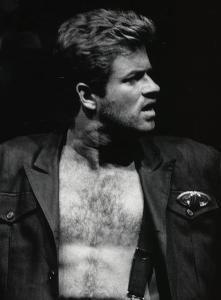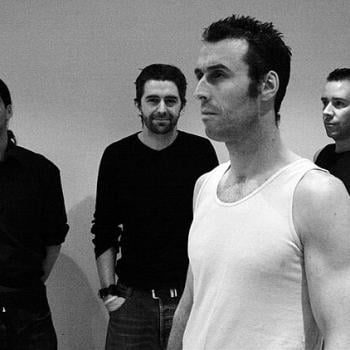This is the first in a two-part series working through a faith-based/Christian critique of pop music. The focus of this article is “Faith” by George Michael.

Why discuss the song (1987) “Faith” by George Michael? This track has been used in the television series House (season 6, episode 9), covered by Limp Bizkit (1998), and hovers in the halls of the late ’80s pop culture. The tour d’ force at the time in pop music drew on hyper-sexualized references and images narrating a positive perspective of lust, desire, fame, and wealth, displayed through active paparazzi pictures and reporting. The synthetic sound and visual aesthetic coined the era. It is in this context that the acoustic-driven, rough male-centered masculinity, and disembodied female are explored under the umbrella of “faith.”
25 Million Copies
“Faith” gained high accolades during this time selling over 25 million copies worldwide, and nominated for such awards as winning the 31st Grammy Award for Album of the Year the 1989 American Music Awards: Favorite Pop/Rock Male Artist, and Favorite Soul/R&B Male Artist, the MTV Video Vanguard Award, and is on the Rolling Stone list of 500 Greatest Albums of All Time (2020).
Given all this notoriety, “Faith” has had little critical analysis or review. The title alone begs for a socio-religious analysis. One would consider a theomusicology interrogation of this pop culture hit to gain an understanding of the gravity that this track still holds. The minimal analyses provided to the chart-topping song fall heavily in favor of the track and skit feverishly away from any socio-religious implications. I argue for the necessity to critically explore the track and the intersectionality of Christian/faith-based and pop culture.
Multiple reviews of the video and lyrics tease out questions for review: “What “faith” is this video referencing?” “Are these images of desire where the audience is sub-textually pointed to situate their “faith”?” “Has culture descended so far that these cut/mixed male-focused/female referenced expressions of gender power and dominance the location of “faith” for the era?”
Talking Faith?

“Faith” came out in 1987 as a hit single for George Michael, formerly of the English duo “Wham!”
A general review of the video states,
“The official video for the song was directed by Andy Morahan [featuring] Michael, with noticeable stubble on his face, wearing a black leather jacket with ‘Rockers Revenge’ and BSA logo,Ray-Ban Aviator sunglasses, a pair of Levi blue jeans, [and] cowboy boots, playing a guitar near a classic-designWurlitzer jukebox, [with] a woman’s bare legs. Writers Bob Batchelor and Scott Stoddart say the music video positions him as a “masculine sex object”, breaking him up into individual body parts such as “stubbled” chin and butt.”
The video begins with another track by George Michael, “I Want Your Sex,” which is quickly interrupted by the start of “Faith.”
In a short interview for American Songwriter, the writer notes, “The title track was not referencing religion or one’s faith, but more of a belief in the end of a relationship, and showing them the door.” The writer does note how the song begins with temptation (read: visually explicit sexual references of both male and female), then pivots to sincerity. This point is where I question the analysis of the writer. The lyrics unfold the disillusionment of a relationship, juxtaposed with the video that promotes physical desire from a male dominant position. Sincerity is far from the scope of both text and visual which work in concert to articulate physical desire and power both of which cannot be substituted for sincerity.
Well, I guess it would be nice if I could touch your body
I know not everybody has got a body like you
But I gotta think twice before I give my heart away
And I know all the games you play because I played them, too
Oh, but I need some time off from that emotion
Time to pick my heart up off the floor
Oh, when that love comes down without devotion
Well, it takes a strong man, baby
But I’m showin’ you the door
The first two lines, “Well, I guess it would be nice if I could touch your body/ I know not everybody has got a body like you,” places an emphasis on physical attraction leading to the next two line that frame the desire as a mechanism of control and power, “But I gotta think twice before I give my heart away/ And I know all the games you play because I played them, too…”
The following stanza qualifies the demise of the physical relationship surrounded by the introduction of an emotional perspective, “Oh, but I need some time off from that emotion/ Time to pick my heart up off the floor.” The following line contextualizes the argument by the protagonist as one vacant of physical and emotional love situating these earthly elements as devotion, “Oh, when that love comes down without devotion.” The cyclic connection between love and devotion is qualified as being sought physically, but vacant in emotion. The protagonist is placing his “faith” in the physical expressions of love and desire generated by the attraction of the unspoken partner. “Faith” is qualified as a surface reference, a synonym for desire. There is no secure-faith-based promotion or willingness to invest.
The closing two lines center the argument on pride. “Well, it takes a strong man, baby/ But I’m showin’ you the door.” Strength, here, is a substitute for pride. This follows the narrative of the lyrics taking aim at multiple steps away from accurate faith-based fellowship, a physical desire that circumnavigates pride. The closing line secures the protagonist’s agenda to continue alone, relying on his own will over that of reconciliation for the obvious shattered relationship, “But I’m showin’ you the door.” Collected together the opening stanza seamlessly flows from desire to pride, and rests on selfishness all founded on a position of power.
Hearing the Word of God
In Michael’s own words, “It represents the way I feel at the moment,…[faith is] another word for my hope and optimism. Faith to me is really such a strong word.” If these opening lyrics refer to how George Michael was feeling at the time, in the last 1980s, being at the rapid ascent of his solo career, thrust in the visual fabric of pop culture, and producing a track that is firmly rooted in music history, what do these words have to do with a faith-based centered relationship with God? If scripture says we are to live by faith, and faith is in hearing the Word of God,
Consequently, faith comes from hearing the message, and the message is heard through the word about Christ. (Romans 10:17 NIV),
What, then, are these lyrics communicating to the larger non-faith-based/non-Christian audience? In the lyrics, faith is a metaphor for personal desire and hearing what one’s emotions and lust promote. Follow those emotions based on the understanding that your own position is acceptable. Further, including the visuals of the video, if you’re a male, your will of power is dominant over the female object who is divorced from any personal interaction and reduced to an icon of desire, without a voice. George Michael was raised Protestant but notes that he held no religious belief system.
“I do not have a religion, but I believe that one can influence one’s life, one’s future, through faith and decency towards others.”
This religious belief d’jour predicts the strong forthcoming wave of New Ageism and the deconstruction movement in Christianity. The danger of such a highly-valued pop icon as George Michael to state such comments gives an eschewed liberty to audiences who are sonically and visually ingesting “faith” as a commodity and a position of gender power. “Faith” is produced and consumed, a prosumption, a spectacle, a token of pop culture demonstrating the “here today/gone tomorrow” attitude of pop culture. The relevant scripture importance of Faith is removed from this context and substituted for one’s means of living (read: basic survival) by their own accord. Michel points to faith being a construction of personal influence, relating to the objectification of being descent to others.

Portraying Faith?
The banality of this statement affords Michel the leverage to expose the visual reduction of the female body. The legs of the female appear only twice in the video, once at the start and later during the guitar solo. Each sequence has the camera ascend the image in a slow lustful manner, a purposeful juxtaposition to Michael’s fluid activity throughout. The shoes are colored in the first sequence, while the entire image is colored in the latter. The limited coloring denotes the irrelevance of the female expression, marking a subdominant position against Michael’s more frequently colored portrait. The fully colored image later follows the lengthy second stanza that reaffirms the male-dominant position of power. The attention to the colored reference of the minimal female anatomy can be read as a segue for personal interaction with the female corpus or, more clearly, the heightened desire of male power to capture the female entity. This colonial expression of power articulates phenomenologically to the viewer of accumulation of masculine dominance in emotional and physical contexts. The female image is reduced to an object of man’s desire and manipulation. For a non-faith-based viewer, the subtext is that one’s self-imposed will and desire can and will faithfully accomplish dominance. The hyper-sexualized content need not be overly stated to form this position. A rationale for the minor cameo of the disembodied female image further situates a male-centered ethic of narcissistic faith.
Absent Faith
The track “Faith” is by no means as simple as others have discussed. Taking into account the sexual tension, emotional controversy, and self-reference of faith, this track presented more complications than accurate attention to faith on any level. Following Michael’s own words about his personal understanding and relationship with faith, it becomes more apparent the track serves a satisfying position in pop culture – there’s no need to understand the scripture reality of faith. Placing an emphasis on one’s own means to resolve relationship issues and descend to constructing pride, male-centered dominance replaces biblical knowledge on the importance of faith. A mass worldwide audience obtained an inverted understanding of faith, by way of a self-referential pop song. Adding Michael’s words to the reading, “faith” remains a subdominant device for man’s manipulation. The spectacle of the male image is juxtaposed with the limited involvement of the female body. Reduced to a slow ascending gaze, the female is colonized and remains a subaltern with no voice to contest the sexual power imbalance. Scripture teaches that by faith we put all our belief in the sovereign power of God,
[S]o that your faith would not rest on the wisdom of men, but on the power of God (1 Corinthians 2:5, NIV).
The inverse of this biblical truth is presented in the work by George Michael. For writers and cultural analysts to overlook the obvious further contextualizes the fear of reading pop culture through a critical Christian/faith-based lens. The necessity for pop culture to frame the word “Faith” as one not to be read through a socio-religious critique further articulates the stereotype that critical attention and a faith-based attitude has no place in the larger local-global environment. George Michael found it personally important enough to explore his faith interest, to the point that he expanded an original 2-minute track to a complete chart-topping hit. The sad reality is the possibility of the 25 million who purchased a copy of “Faith” (both record and single) they found a dead-end path to the personal application of accurate Faith. Leaning on one’s own desires (read: George Michael) as an example of how to live by desire, power accumulation, and pride frames the understanding of Faith as one of a mass market product for pop cultural consumption. George Michael held the proverbial microphone and could have broadcast a strong position of scripture-founded Faith. Yet, he dissolved to his own failure of a selfish reference of Faith as a token to be packaged and sold worldwide.














